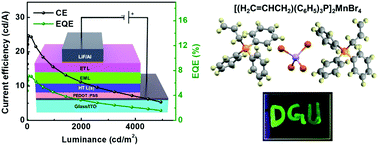Efficient organic manganese(ii) bromide green-light-emitting diodes enabled by manipulating the hole and electron transport layer†
Abstract
Lead-free, non-toxic transition metal-based phosphorescent organic–inorganic hybrid (OIH) compounds are promising for next-generation flat-panel displays and solid-state light-emitting devices. In the present study, we fabricate highly efficient phosphorescent green-light-emitting diodes (PHOLEDs) using the lead-free, non-toxic, zero-dimensional OIH compound [(H2C![[double bond, length as m-dash]](https://www.rsc.org/images/entities/char_e001.gif) CHCH2)(C6H5)3P]2MnBr4 (1), which exhibits an emission peak at 516 nm and a long lifetime of 441 μs. The long lifetime indicates the phosphorescent emissive nature of 1. Density functional theory calculations confirm that the narrow green emission from 1 is due to the highly localized electronic states of the valence and conduction bands. A flexible green-light-emitting phosphorescent substrate is successfully fabricated from 1 using a nylon membrane, indicating that 1 has a significant potential for use in flexible optoelectronic devices. By engineering the organic hole and electron transport layers, we achieve a highly efficient all-vacuum-deposited PHOLED with a current efficiency of 24.71 cd A−1, a power efficiency of 20.61 lm W−1, and an external quantum efficiency of 7.12%. Together, our findings will pave the way for the development of high-performance Mn(II)-based LEDs.
CHCH2)(C6H5)3P]2MnBr4 (1), which exhibits an emission peak at 516 nm and a long lifetime of 441 μs. The long lifetime indicates the phosphorescent emissive nature of 1. Density functional theory calculations confirm that the narrow green emission from 1 is due to the highly localized electronic states of the valence and conduction bands. A flexible green-light-emitting phosphorescent substrate is successfully fabricated from 1 using a nylon membrane, indicating that 1 has a significant potential for use in flexible optoelectronic devices. By engineering the organic hole and electron transport layers, we achieve a highly efficient all-vacuum-deposited PHOLED with a current efficiency of 24.71 cd A−1, a power efficiency of 20.61 lm W−1, and an external quantum efficiency of 7.12%. Together, our findings will pave the way for the development of high-performance Mn(II)-based LEDs.



 Please wait while we load your content...
Please wait while we load your content...